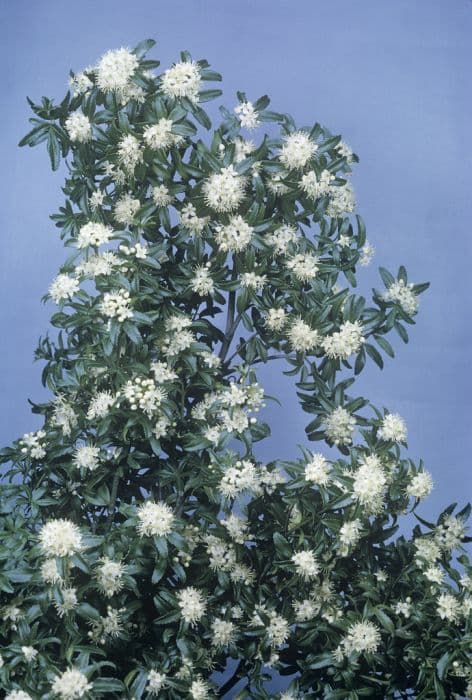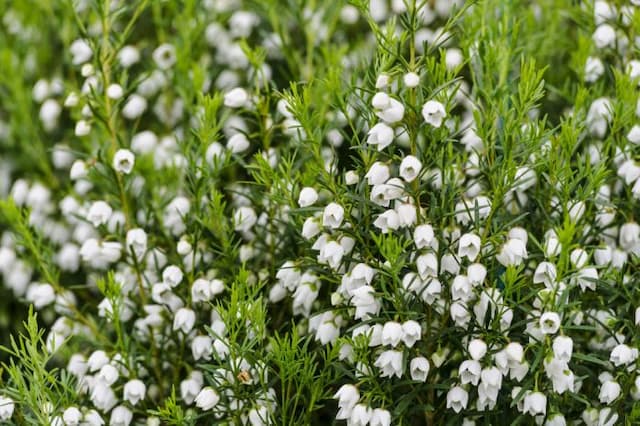Skimmia 'Veitchii' Skimmia japonica 'Veitchii' (f)

ABOUT
'Veitchii' is an upright, evergreen, dense shrub, to 1.5m tall and wide, with broadly-oval, rich green leaves. Dense clusters of small, star-shaped, white spring flowers are followed by brilliant red spherical fruit
About this plant
 Names
NamesFamily
Rutaceae
Synonyms
Japanese Skimmia, Ogon Skimmia, Fragrant Skimmia
Common names
Skimmia japonica 'Veitchii' (f).
 Characteristics
CharacteristicsLife cycle
Perennials
Foliage type
Evergreen
Color of leaves
Green
Flower color
White
Height
3-4 feet (0.9-1.2 meters)
Spread
3-4 feet (0.9-1.2 meters)
Plant type
Shrub
Hardiness zones
6-8
Native area
Japan
Benefits
 General Benefits
General Benefits- Easy to care for – Skimmia japonica 'Veitchii' is a low-maintenance plant that does not require much attention once established.
- Year-round interest – With evergreen foliage, it provides visual interest in the garden throughout all seasons.
- Attracts wildlife – The flowers can attract pollinators like bees, and the berries are a food source for birds.
- Tolerance of shade – It thrives in partial to full shade, making it suitable for darker corners of the garden.
- Drought resistance – Once established, it's relatively drought-tolerant, requiring less frequent watering.
- Compact size – It has a naturally compact and rounded habit, ideal for small gardens or spaces.
- Decorative berries – Produces bright red berries that add color and interest to the winter garden landscape.
- Fragrant flowers – The plant produces fragrant white or light pink flowers that are pleasant for passersby.
- Ornamental foliage – The leaves are a dark, glossy green adding texture and contrast to garden compositions.
- Easy to propagate – Skimmia japonica 'Veitchii' can be propagated from semi-ripe cuttings, allowing gardeners to create new plants.
 Medical Properties
Medical PropertiesThis plant is not used for medical purposes.
 Air-purifying Qualities
Air-purifying QualitiesThis plant is not specifically known for air purifying qualities.
 Other Uses
Other Uses- Decorative winter berries: Skimmia's female plants produce red berries that remain on the plant throughout winter, providing a splash of color in otherwise dormant gardens.
- Aromatic foliage: When crushed, the leaves of the Skimmia release a pleasant aromatic scent, which can be used to create natural potpourris.
- Floral arrangements: Skimmia's evergreen foliage and clusters of red berries are often used in floral arrangements, particularly in winter displays.
- Privacy screening: Planted in groups, Skimmia can form a dense, evergreen screen, offering privacy throughout the year.
- Bonsai plant: Due to its compact size and attractive features, Skimmia can be trained as a bonsai for indoor or outdoor decoration.
- Ground cover: Skimmia plants can be used as ground cover in shaded areas, where they can help prevent soil erosion and suppress weeds.
- Festive decorations: Branches of Skimmia, with their berries and foliage, are often included in Christmas wreaths and table centrepieces.
- Theme garden accent: Skimmia can be used in an Asian-themed garden to complement other Asian flora, thanks to its oriental origin and appearance.
- Fauna habitat: Being dense and evergreen, Skimmia provides shelter for birds and beneficial insects, especially during colder months.
- Water garden companion: Skimmia plants can be placed around water features, like ponds, to add texture and color contrast with their glossy leaves and berries.
Interesting Facts
 Feng Shui
Feng ShuiThe Skimmia is not used in Feng Shui practice.
 Zodiac Sign Compitability
Zodiac Sign CompitabilityThe Skimmia is not used in astrology practice.
 Plant Symbolism
Plant Symbolism- Protection: Skimmia is often associated with protection due to its robust nature and the way it can thrive in many conditions, acting as a guardian for less hardy plants.
- Longevity: With its evergreen leaves, the Skimmia represents longevity and the enduring aspects of life, staying green and vibrant throughout the seasons.
- Resilience: The Skimmia's ability to survive in shade and its resistance to many common plant diseases symbolize resilience and the ability to thrive despite challenges.
- Purity: The pristine white flowers of Skimmia may represent purity and innocence, commonly associated with the color white in the floral language.
 Water
WaterJapanese Skimmia prefers evenly moist but well-draining soil, so it's important to water when the top inch of soil feels dry to the touch without overwatering. Generally, this plant will require watering every week or two, depending on climate conditions and season. During hot, dry periods, Japanese Skimmia may need to be watered more frequently. Provide roughly 1 gallon of water for outdoor plants or slightly less for potted specimens to ensure the root zone is sufficiently moist. In winter, reduce watering frequency, as the plant requires less moisture due to slower growth and cooler temperatures.
 Light
LightJapanese Skimmia thrives in partial shade to full shade locations, where it can be protected from the harsh afternoon sun. The ideal spot for this plant is under the canopy of larger trees or on the north side of a building, where it will receive dappled sunlight or light shade throughout the day. Avoid placing Japanese Skimmia in full sun, as it may lead to scorched leaves and stress the plant.
 Temperature
TemperatureJapanese Skimmia can tolerate a range of temperatures but performs best in areas where average daytime temperatures are between 60 and 75 degrees Fahrenheit. It can survive in temperatures as low as 0 degrees Fahrenheit but should be protected from severe cold snaps. Ideally, provide a location that remains relatively cool and avoids the extremes of both winter chill and summer heat.
 Pruning
PruningPruning Japanese Skimmia is primarily done to shape the plant or remove any damaged or dead growth. It's best to prune in late winter or early spring before new growth emerges. You can also prune after the plant has finished flowering to maintain a desirable size. Generally, pruning once a year is sufficient unless you are dealing with dead branches, which should be removed as needed.
 Cleaning
CleaningAs needed
 Soil
SoilJapanese Skimmia thrives in a well-draining, acidic soil mix with a pH of 5.5 to 6.5. A blend of peat, pine bark, and perlite or sand makes an ideal growing medium for this plant.
 Repotting
RepottingJapanese Skimmia should be repotted every two to three years to refresh the soil and encourage healthy growth.
 Humidity & Misting
Humidity & MistingJapanese Skimmia prefers moderate to high humidity levels for optimal growth.
 Suitable locations
Suitable locationsIndoor
Place in bright, indirect light, keep soil lightly moist.
Outdoor
Shaded location, well-draining acidic soil, shelter from harsh winds.
Hardiness zone
7-9 USDA
 Life cycle
Life cycleSkimmia japonica 'Veitchii' (female), commonly known as Japanese Skimmia, begins its life cycle when the seeds, often dispersed by birds, germinate in moist, well-drained soil with partial shade. The seedlings emerge and slowly grow into compact evergreen shrubs, developing glossy, leathery leaves. As the plant matures, it begins its reproductive stage, producing fragrant white flowers in the spring, which are pollinated by insects. Following pollination, if a male plant is nearby to provide pollen, the female Skimmia japonica 'Veitchii' develops red berries in the autumn, which persist through the winter and are a food source for birds. The shrub reaches full maturity in several years and can live for many years, requiring minimal maintenance. Throughout its life, the Japanese Skimmia remains an attractive plant due to its evergreen foliage, with seasonal interest from its flowers and berries.
 Propogation
PropogationPropogation time
Early Spring
The Skimmia japonica 'Veitchii' is typically propagated through semi-hardwood cuttings. The optimal time for taking cuttings is in late summer, when the new growth has begun to mature and harden. To propagate, a gardener would take a cutting of about 4 to 6 inches (approximately 10 to 15 centimeters) in length, making sure it includes at least two or three sets of leaves. The lower leaves are then removed, and the cut end is dipped in rooting hormone to encourage root growth. After this, the cutting is placed in a pot filled with a well-draining rooting medium and kept in a humid environment with indirect sunlight. If the conditions are ideal, the cutting should develop roots within a few weeks, after which it can be transplanted into a larger container or directly into the garden.


![Mexican orange [Sundance]](/_next/image?url=https%3A%2F%2Fplants-admin.emdemapps.com%2Fimages%2Fplants%2F%2Fimages%2F604b5381bcf0d.png&w=640&q=75)






